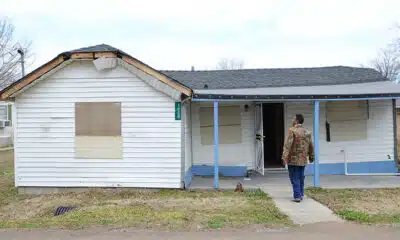Kaiser Health News
California’s Medicaid Experiment Spends Money to Save Money — And Help the Homeless
by Angela Hart
Wed, 19 Apr 2023 09:00:00 +0000
SAN DIEGO — Sporting a bright smile and the polished Super Bowl ring he won as a star NFL player in the late 1980s, Craig McEwen doesn’t fit the archetype of someone teetering on the brink of homelessness.
Evicted from his San Diego County apartment last July, McEwen — who endured repeated concussions during his six seasons in the NFL — scoured housing listings for anything he could afford.
Working as a part-time groundskeeper at a golf course for $15 an hour, his frantic search turned up nothing. So, feeling overwhelmed by rents pushing $3,000 a month for a one-bedroom apartment, he made a plan: move into his truck or rent a storage container to live in — an alternative he turned to when he was previously homeless in 2004.
McEwen is hopeful that a massive health care initiative in California offering new, specialized social services will help him get back on his feet. He is one of nearly 145,000 low-income Californians enrolled in CalAIM, an endeavor Gavin Newsom, the state’s Democratic governor, is spearheading to transform its Medicaid program, called Medi-Cal, into a new kind of safety net that provides housing and other services for people who are homeless or at risk of becoming homeless and have complicating conditions like mental illness or chronic disease that can make it difficult to manage life.
California launched the initiative in early 2022, rolling it out quietly, with health insurers and community groups scrambling to provide social services and benefits that fall outside traditional health care. It’s a five-year, $12 billion social experiment that Newsom is betting will eventually cut soaring health care spending in Medi-Cal, the largest Medicaid program in the country with 15.5 million enrollees.
The state is contracting the work to its 23 Medi-Cal managed-care health insurance companies. They are responsible for delivering a slew of new benefits to the most vulnerable enrollees: not only those with housing insecurity, but also people with mental health or addictive disorders; formerly incarcerated people transitioning back to society; seniors and people with disabilities; children in foster care; and Californians who frequent hospital emergency rooms or are admitted often to short-term skilled nursing facilities.
While only a sliver of the state’s Medi-Cal patients are enrolled in CalAIM, tens of thousands of low-income Californians could qualify for the new benefits. They’re eligible for help in finding housing and for paying rental move-in costs like security deposits.
But the help goes beyond housing. The state is also providing the most at-risk patients with intensive case management, alongside pioneering social services — such as healthy home-delivered meals for diabetes patients and mold removal in homes of patients with severe asthma.
Top state health officials say that with such an ambitious program — using Medicaid to help solve homelessness and combat chronic disease — they expected the rollout to be bumpy. After 2026, when the initiative’s funding ends, the state plans to prove the experiment works and permanently adopt the benefits. Meanwhile, other states are closely watching California, hoping to learn from its successes and failures.
“California is a leader, and it’s always experimenting in new and interesting ways,” said Dr. Georges Benjamin, executive director of the American Public Health Association. “What it can do is provide proof of concept, and then this can grow to other states.”
Insurers, in essence, are building a new health care workforce, contracting with nonprofit and for-profit organizations to enroll the most vulnerable — and expensive — Medi-Cal patients. They’re hiring social workers and case managers to find those who rack up extreme health care costs in hospital emergency rooms, nursing homes, prisons, jails, and mental health crisis centers.
As Newsom sees it, the immense investment will pay off for taxpayers. Targeting people cycling in and out of costly institutions will reduce health care spending, he argues, while also helping people get healthy. State health officials say 5% of high-need Medi-Cal patients account for roughly half of all health care spending in the low-income health care program.
The most important currency in pulling off this massive health care experiment is trust. And that is being built on the ground, with community outreach workers scouring hospitals and homeless encampments, for example, to find those eligible for CalAIM.
The most at-risk Medi-Cal patients are being linked to specialized teams deployed under a new entitlement benefit at the heart of the initiative called “enhanced care management.” While other services like covering security deposits are optional, this is not. Health insurers are required to accept people who are most in need and provide a wide range of health and social services.
It can be simple things like arranging an Uber to get to a medical appointment or buying a computer for an enrollee looking for a job. Or purchasing a bike for a low-income kid. But it also involves intensive, one-on-one work that can require case managers to take patients to get an identification card, make nighttime phone calls to ensure patients are taking medications, and hunt down available apartments.
“This is the missing piece, and it’s the hardest work — the most costly work,” Newsom said in an interview with KFF Health News. “People on the streets and sidewalks, they’ve lost trust. They’ve become socially isolated. They’ve lost connection, and so developing that is so foundational.”
‘My Own Prison’
McEwen, who was a tight end for the NFL team now known as the Washington Commanders and later for the San Diego Chargers, was hailed as a “legacy.” But playing professional football took an extreme toll.
“My position was to block for the quarterback, and back in the day, you were allowed to hit people in the head,” McEwen said, recalling regular concussions on the field that he’d snap himself out of by sniffing ammonia packets. He helped lead the Washington team to a Super Bowl victory in 1987, but in the decades since, his health has deteriorated.
McEwen has struggled for years to find regular work while dealing with thoughts of suicide, anger, forgetfulness, and depression that he says stem from traumatic brain injuries sustained during his football career. At 57, he endures continual pain from ruptured disks in his neck and spine, along with shortness of breath from severe heart disease.
He’d holed up in his apartment for years, with curtains nailed to his windows, drowning his pain with alcohol. “I basically created my own prison,” he said.
After he was evicted last July, a longtime friend swooped in to let him stay temporarily in a spare bedroom at his family’s house just outside San Diego. But McEwen’s financial and emotional struggle to find stable housing hasn’t ended.
“We don’t call it fear. Us ballplayers, we call it excitement,” McEwen said on a rainy morning in early March, his eyes swelling with tears. “I’m excited. I know what’s at stake. My life is at stake.”
Housing instability is just one part of it. He’d often forget to take his medications for high cholesterol and clogged arteries. He felt paralyzing anxiety and his brain was so scrambled he’d miss important doctor appointments — a side effect, he said, of the concussions.
McEwen knew he needed help.
He’d learned from a friend that California was helping Medi-Cal patients with not just medical needs but also social services, and he started making calls, insisting on getting in. “I said wait, you’re giving people a coach? Someone who can make appointments for me and go to my doctor visits with me?”
Weeks after receiving his eviction notice, his Medi-Cal insurer, Molina Healthcare, connected him with a personal care manager, whom McEwen calls “my advocate, someone who can teach me how to do for myself and give myself a life worth living.”
But who gets in the program is often a roll of the dice, depending largely on which Medi-Cal insurance company a person is enrolled in. Persistence plays a big role.
Despite early glimmers of hope, the rollout has been chaotic. Providers on the ground scramble to find any available housing for enrollees. Groups implementing the initiative say inadequate funding and dire health workforce shortages have severely constrained their ability to serve all those in need. And enrollment by health insurers is uneven, with some quickly approving new benefits for their members while others are denied. Some insurers provide on-the-spot Uber rides for doctor appointments while others offer only a bus pass.
“What is being offered is insufficient, and this program is not set up to support those who are actually the most vulnerable and need the most intensive support,” said Nancy Behm, associate director of CalAIM for a San Diego nonprofit called People Assisting the Homeless, or PATH.
Operating under contracts with Blue Shield of California, Molina Healthcare, and Health Net, PATH launched intensive case management and housing services in January 2022. But it has since stopped providing intensive case management benefits largely due to a lack of sufficient funding to do the grueling work of connecting with homeless people living in encampments. “We’re hitting barriers on every front,” Behm said.
Newsom, with his soaring political ambitions, is promising to help the most vulnerable Californians. Termed out in 2026, speculation is mounting that the two-term governor is eyeing a presidential run, and he’s using health care as a core issue to elevate his national profile. In reality, his Medi-Cal initiative is falling far short.
“This is an extremely ambitious program, but it doesn’t come close to helping the entirety of the population it’s targeting,” said Doug Herman, who worked for former President Barack Obama and former Los Angeles Mayor Eric Garcetti. “This isn’t a policy solution big enough to really make a dent in homelessness.”
No Walk in the Park
On a brisk morning in late February, Jeannine Nash pulled into the drive-thru of a Jack in the Box in Chula Vista, just south of San Diego. She dug in her wallet to find $8.17 for 10 breakfast sandwiches to hand out to homeless people on her regular rounds visiting encampments.
“It helps me to come out here before work, to get an idea of what the needs are,” Nash said as she approached a nearby homeless woman slumped over on a sidewalk who had nothing with her but a brand-new walker and hospital discharge paperwork tucked in a plastic bag.
Nash is director of referrals for Serene Health, a for-profit health care company that is one of nearly 500 provider organizations being paid to link homeless people or those at risk with intensive case management, housing, and other services.
A recovering addict herself, Nash said her life experience has helped her connect with people living outside and struggling with substance use disorders. She figures out how to get those who appear resistant to accept services. “So many people are distrustful of authority,” said Nash, who has a son who is homeless.
“This is very, very dear to my heart,” Nash said. In her decades since becoming sober, she has gained deep experience getting the people most at risk of spiraling deeper into crisis into treatment beds and even apartments. She’s cultivated relationships with housing and nursing home agencies so she can quickly identify openings.
But her job comes with extraordinary challenges. She often has to level with people living outside, telling them there is simply nowhere for them to go. “There’s just not enough beds or housing out there,” she said. “And if you don’t have an income, it’s not going to happen.”
Nash handed the homeless woman in the doorway two sandwiches, coaxing her to eat. The woman, Christina Gallegos, 38, was suffering from extreme liver damage due to chronic drinking and had crawled the few blocks from Scripps Mercy Hospital in Chula Vista, where she was discharged the night before.
She had been in the emergency room, her hospital discharge paperwork showed — one of several ER trips she’d made in the past month. She was given the walker but couldn’t walk and dragged it into a doorway for shelter.
“We see this all the time. It’s getting really bad,” Nash said, texting her contacts to find a bed for Gallegos. “She’s definitely eligible. It’s just finding somewhere for her to go that is going to be hard.”
Gallegos has Medi-Cal but hasn’t been enrolled in the new benefits California is offering. She was among an estimated 8,500 homeless people identified in San Diego County in 2022, a 10% increase since 2020.
San Diego County is massive and populous, and while homeless encampments permeate suburban enclaves like Chula Vista, homeless people are largely clustered in San Diego’s downtown neighborhood and its parks.
One popular place to pitch a tent is Balboa Park near the San Diego Zoo. Its canyons and sprawling green lawns are peppered with tent communities, whose inhabitants plead for help from community groups. Many hang on to business cards from homeless outreach workers in hopes of scoring a shelter bed or permanent housing. While some people do get housing, many feel as if outreach efforts amount to broken promises.
One man, David Lloyd, pulled from his pocket a phone number for an outreach worker from the homeless services provider PATH, who told him that he was on a waiting list for housing but that he could be waiting in the queue for years.
“It’s a big list,” said Lloyd, 66. “I just want to get off the streets. I’m tired of the cops harassing me all the time.”
Cally Wood, 35, said she is addicted to fentanyl and has been on the waiting list for housing for more than a year. “It just feels really impossible,” she said. “There’s nothing affordable.”
Health insurance executives, including Martha Santana-Chin, Medi-Cal president for Health Net in California, said Medi-Cal managed-care plans are making progress in helping get people off the streets and into services. Yet she acknowledged the initial rollout falls short.
“We just don’t have the housing supply that we need,” Santana-Chin said, “to be confident that all of these folks who need support and services are going to get permanently placed.”
Hampered by Sweeps
Across the region, sweeps of homeless encampments are common and becoming part of everyday life for people living outside. Deteriorating and unsanitary conditions on the streets fuel public frustration.
Newsom has ratcheted up the practice of clearing encampments, arguing that people dealing with homelessness should not be allowed to live outdoors, despite a dearth of alternatives. He’s allocating state funding to cities and counties to remove tents from streets and sidewalks and move people into any shelter or housing available. San Diego Mayor Todd Gloria, also a Democrat, is unapologetic about adopting the approach.
“We’re doing the cleanups that are necessary for public safety,” Gloria told KFF Health News. “These conditions are unsanitary, and it puts people’s health and safety at risk, and it leads to people dying. Some people disagree with me under the guise of caring for these individuals, but the sidewalk is not a home.”
Outreach workers on the ground, however, say the enforcement crackdown only makes their jobs harder. One of the most critical goals of the new Medi-Cal initiative is to regularly visit people on the streets, build relationships with them, and help them with health care needs, all while preparing them for housing — if it becomes available.
“This really takes a lot of time. Sometimes you start with just bringing someone socks or a bottle of water. It can take 70 encounters for someone to accept our help,” said Andrea Karrer, an outreach worker with PATH. “But that time is what allows you to build trust with someone, and when they have to constantly move, you have to find that person, and sometimes start all over.”
And the disruptions ultimately cause people without housing to get sicker and visit the ER more often, she and other outreach workers said.
“When you have to move every two or three days, getting to the doctor or staying on medication is not the biggest priority. You’re in survival mode,” Karrer said.
A Labor-Intensive Effort
Serene Health is one of hundreds of providers enrolling Medi-Cal patients into intensive case management. Together, they have signed up 108,000 patients statewide so far, according to California’s Department of Health Care Services, which administers Medi-Cal. An additional 28,000 are receiving the new housing services such as security deposit payments and help identifying affordable housing.
“A lot of the stuff we’re doing is just really new to health care,” said Jacey Cooper, the state’s Medicaid director. She said that health insurers are offering housing services in all 58 counties, yet she acknowledged that the need exceeds capacity.
“It takes time for that infrastructure to come to fruition,” Cooper said of the challenge of identifying housing for Medi-Cal patients who frequent hospital ERs. “We are in a massive education moment of even making sure people understand who’s eligible and how to refer, and educating the entire delivery system, from hospitals to providers.”
Meanwhile, Newsom is asking the Biden administration for permission to add another housing benefit that would cover up to six months of direct rent payments.
Veronica Ortiz, a lead care manager for Serene Health, has Craig McEwen on her roster of about 60 patients — a large caseload that is difficult to manage.
But Ortiz bubbles with compassion and energy and said working with patients like McEwen has given her even more drive to make a difference. The work is arduous, but McEwen is quickly becoming more independent, she said.
“When we come into their lives, we’re strangers, so we have to spend a lot of time meeting face-to-face with people and helping with anything they need, otherwise they’re not going to trust us.”
But help didn’t come fast enough for Donna Fontenot, a San Diego County resident who is being evicted from her apartment this month. Her landlord told her she had to leave following repeated ER trips, hospitalizations, and skilled nursing home stays stemming from an initial fall in 2022 that left her in a wheelchair.
“I’m petrified and absolutely panicking, I have nowhere to go,” Fontenot said. With one hospitalization alone costing an average of $18,000 in California, Fontenot, who is on Medi-Cal, has racked up high health care costs.
She has been hospitalized eight times since March 2022, she said. And on five occasions, her injuries to her feet and legs were so extreme that she needed placement in a nursing home.
Yet her Medi-Cal insurer, the San Diego-based Community Health Group, instituted a rule that to qualify for some housing services, she must have a child under 18. So she isn’t receiving housing assistance that could help her. She is, however, enrolled in intensive case management. But she was not aware of that until KFF Health News informed her.
“I feel like I won the lottery,” she said. “Is it going to help me?”
Her care manager hasn’t been as involved in her life as Ortiz has been with McEwen. Fontenot continues to search on her own for housing, and recently asked to be switched into Serene Health to get more hands-on assistance. “I’ve never needed help like this before. I feel so broken,” she said in tears. “Where am I going to go?”
Today, Ortiz is helping McEwen search for housing. She also has focused on helping him get his heart condition under control and find more stable work.
In March, he landed a job as a security guard patrolling sporting events, including at football stadiums. And he scored a hard-to-get surgery appointment for late this month to help unclog the arteries in his heart.
“Before Veronica, I was waiting to die. I was eating and drinking to die. But she showed up for me. Somebody cared about me. And that gave me the courage to share with her what my dream would be,” McEwen said. “I thought I needed football to be loved — then I’d be worth it.
“But I know now that my true purpose is to be of service and to be there for my daughter. I decided to get back on the field, instead of sitting on the sidelines.”
This article was produced by KFF Health News, which publishes California Healthline, an editorially independent service of the California Health Care Foundation.
KFF Health News is a national newsroom that produces in-depth journalism about health issues and is one of the core operating programs at KFF—an independent source of health policy research, polling, and journalism. Learn more about KFF.
USE OUR CONTENT
This story can be republished for free (details).
By: Angela Hart
Title: California’s Medicaid Experiment Spends Money to Save Money — And Help the Homeless
Sourced From: kffhealthnews.org/news/article/california-homelessness-calaim-program-medicaid-experiment/
Published Date: Wed, 19 Apr 2023 09:00:00 +0000
Kaiser Health News
Dual Threats From Trump and GOP Imperil Nursing Homes and Their Foreign-Born Workers
In a top-rated nursing home in Alexandria, Virginia, the Rev. Donald Goodness is cared for by nurses and aides from various parts of Africa. One of them, Jackline Conteh, a naturalized citizen and nurse assistant from Sierra Leone, bathes and helps dress him most days and vigilantly intercepts any meal headed his way that contains gluten, as Goodness has celiac disease.
“We are full of people who come from other countries,” Goodness, 92, said about Goodwin House Alexandria’s staff. Without them, the retired Episcopal priest said, “I would be, and my building would be, desolate.”
The long-term health care industry is facing a double whammy from President Donald Trump’s crackdown on immigrants and the GOP’s proposals to reduce Medicaid spending. The industry is highly dependent on foreign workers: More than 800,000 immigrants and naturalized citizens comprise 28% of direct care employees at home care agencies, nursing homes, assisted living facilities, and other long-term care companies.
But in January, the Trump administration rescinded former President Joe Biden’s 2021 policy that protected health care facilities from Immigration and Customs Enforcement raids. The administration’s broad immigration crackdown threatens to drastically reduce the number of current and future workers for the industry. “People may be here on a green card, and they are afraid ICE is going to show up,” said Katie Smith Sloan, president of LeadingAge, an association of nonprofits that care for older adults.
Existing staffing shortages and quality-of-care problems would be compounded by other policies pushed by Trump and the Republican-led Congress, according to nursing home officials, resident advocates, and academic experts. Federal spending cuts under negotiation may strip nursing homes of some of their largest revenue sources by limiting ways states leverage Medicaid money and making it harder for new nursing home residents to retroactively qualify for Medicaid. Care for 6 in 10 residents is paid for by Medicaid, the state-federal health program for poor or disabled Americans.
“We are facing the collision of two policies here that could further erode staffing in nursing homes and present health outcome challenges,” said Eric Roberts, an associate professor of internal medicine at the University of Pennsylvania.
The industry hasn’t recovered from covid-19, which killed more than 200,000 long-term care facility residents and workers and led to massive staff attrition and turnover. Nursing homes have struggled to replace licensed nurses, who can find better-paying jobs at hospitals and doctors’ offices, as well as nursing assistants, who can earn more working at big-box stores or fast-food joints. Quality issues that preceded the pandemic have expanded: The percentage of nursing homes that federal health inspectors cited for putting residents in jeopardy of immediate harm or death has risen alarmingly from 17% in 2015 to 28% in 2024.
In addition to seeking to reduce Medicaid spending, congressional Republicans have proposed shelving the biggest nursing home reform in decades: a Biden-era rule mandating minimum staffing levels that would require most of the nation’s nearly 15,000 nursing homes to hire more workers.
The long-term care industry expects demand for direct care workers to burgeon with an influx of aging baby boomers needing professional care. The Census Bureau has projected the number of people 65 and older would grow from 63 million this year to 82 million in 2050.
In an email, Vianca Rodriguez Feliciano, a spokesperson for the Department of Health and Human Services, said the agency “is committed to supporting a strong, stable long-term care workforce” and “continues to work with states and providers to ensure quality care for older adults and individuals with disabilities.” In a separate email, Tricia McLaughlin, a Department of Homeland Security spokesperson, said foreigners wanting to work as caregivers “need to do that by coming here the legal way” but did not address the effect on the long-term care workforce of deportations of classes of authorized immigrants.
Goodwin Living, a faith-based nonprofit, runs three retirement communities in northern Virginia for people who live independently, need a little assistance each day, have memory issues, or require the availability of around-the-clock nurses. It also operates a retirement community in Washington, D.C. Medicare rates Goodwin House Alexandria as one of the best-staffed nursing homes in the country. Forty percent of the organization’s 1,450 employees are foreign-born and are either seeking citizenship or are already naturalized, according to Lindsay Hutter, a Goodwin spokesperson.
“As an employer, we see they stay on with us, they have longer tenure, they are more committed to the organization,” said Rob Liebreich, Goodwin’s president and CEO.
Jackline Conteh spent much of her youth shuttling between Sierra Leone, Liberia, and Ghana to avoid wars and tribal conflicts. Her mother was killed by a stray bullet in her home country of Liberia, Conteh said. “She was sitting outside,” Conteh, 56, recalled in an interview.
Conteh was working as a nurse in a hospital in Sierra Leone in 2009 when she learned of a lottery for visas to come to the United States. She won, though she couldn’t afford to bring her husband and two children along at the time. After she got a nursing assistant certification, Goodwin hired her in 2012.
Conteh said taking care of elders is embedded in the culture of African families. When she was 9, she helped feed and dress her grandmother, a job that rotated among her and her sisters. She washed her father when he was dying of prostate cancer. Her husband joined her in the United States in 2017; she cares for him because he has heart failure.
“Nearly every one of us from Africa, we know how to care for older adults,” she said.
Her daughter is now in the United States, while her son is still in Africa. Conteh said she sends money to him, her mother-in-law, and one of her sisters.
In the nursing home where Goodness and 89 other residents live, Conteh helps with daily tasks like dressing and eating, checks residents’ skin for signs of swelling or sores, and tries to help them avoid falling or getting disoriented. Of 102 employees in the building, broken up into eight residential wings called “small houses” and a wing for memory care, at least 72 were born abroad, Hutter said.
Donald Goodness grew up in Rochester, New York, and spent 25 years as rector of The Church of the Ascension in New York City, retiring in 1997. He and his late wife moved to Alexandria to be closer to their daughter, and in 2011 they moved into independent living at the Goodwin House. In 2023 he moved into one of the skilled nursing small houses, where Conteh started caring for him.
“I have a bad leg and I can’t stand on it very much, or I’d fall over,” he said. “She’s in there at 7:30 in the morning, and she helps me bathe.” Goodness said Conteh is exacting about cleanliness and will tell the housekeepers if his room is not kept properly.
Conteh said Goodness was withdrawn when he first arrived. “He don’t want to come out, he want to eat in his room,” she said. “He don’t want to be with the other people in the dining room, so I start making friends with him.”
She showed him a photo of Sierra Leone on her phone and told him of the weather there. He told her about his work at the church and how his wife did laundry for the choir. The breakthrough, she said, came one day when he agreed to lunch with her in the dining room. Long out of his shell, Goodness now sits on the community’s resident council and enjoys distributing the mail to other residents on his floor.
“The people that work in my building become so important to us,” Goodness said.
While Trump’s 2024 election campaign focused on foreigners here without authorization, his administration has broadened to target those legally here, including refugees who fled countries beset by wars or natural disasters. This month, the Department of Homeland Security revoked the work permits for migrants and refugees from Cuba, Haiti, Nicaragua, and Venezuela who arrived under a Biden-era program.
“I’ve just spent my morning firing good, honest people because the federal government told us that we had to,” Rachel Blumberg, president of the Toby & Leon Cooperman Sinai Residences of Boca Raton, a Florida retirement community, said in a video posted on LinkedIn. “I am so sick of people saying that we are deporting people because they are criminals. Let me tell you, they are not all criminals.”
At Goodwin House, Conteh is fearful for her fellow immigrants. Foreign workers at Goodwin rarely talk about their backgrounds. “They’re scared,” she said. “Nobody trusts anybody.” Her neighbors in her apartment complex fled the U.S. in December and returned to Sierra Leone after Trump won the election, leaving their children with relatives.
“If all these people leave the United States, they go back to Africa or to their various countries, what will become of our residents?” Conteh asked. “What will become of our old people that we’re taking care of?”
KFF Health News is a national newsroom that produces in-depth journalism about health issues and is one of the core operating programs at KFF—an independent source of health policy research, polling, and journalism. Learn more about KFF.
Subscribe to KFF Health News’ free Morning Briefing.
This article first appeared on KFF Health News and is republished here under a Creative Commons license.
The post Dual Threats From Trump and GOP Imperil Nursing Homes and Their Foreign-Born Workers appeared first on kffhealthnews.org
Note: The following A.I. based commentary is not part of the original article, reproduced above, but is offered in the hopes that it will promote greater media literacy and critical thinking, by making any potential bias more visible to the reader –Staff Editor.
Political Bias Rating: Center-Left
This content primarily highlights concerns about the impact of restrictive immigration policies and Medicaid spending cuts proposed by the Trump administration and Republican lawmakers on the long-term care industry. It emphasizes the importance of immigrant workers in healthcare, the challenges that staffing shortages pose to patient care, and the potential negative effects of GOP policy proposals. The tone is critical of these policies while sympathetic toward immigrant workers and advocates for maintaining or increasing government support for healthcare funding. The framing aligns with a center-left perspective, focusing on social welfare, immigrant rights, and concern about the consequences of conservative economic and immigration policies without descending into partisan rhetoric.
Kaiser Health News
California’s Much-Touted IVF Law May Be Delayed Until 2026, Leaving Many in the Lurch
California lawmakers are poised to delay the state’s much-ballyhooed new law mandating in vitro fertilization insurance coverage for millions, set to take effect July 1. Gov. Gavin Newsom has asked lawmakers to push the implementation date to January 2026, leaving patients, insurers, and employers in limbo.
The law, SB 729, requires state-regulated health plans offered by large employers to cover infertility diagnosis and treatment, including IVF. Nine million people will qualify for coverage under the law. Advocates have praised the law as “a major win for Californians,” especially in making same-sex couples and aspiring single parents eligible, though cost concerns limited the mandate’s breadth.
People who had been planning fertility care based on the original timeline are now “left in a holding pattern facing more uncertainty, financial strain, and emotional distress,” Alise Powell, a director at Resolve: The National Infertility Association, said in a statement.
During IVF, a patient’s eggs are retrieved, combined with sperm in a lab, and then transferred to a person’s uterus. A single cycle can total around $25,000, out of reach for many. The California law requires insurers to cover up to three egg retrievals and an unlimited number of embryo transfers.
Not everyone’s coverage would be affected by the delay. Even if the law took effect July 1, it wouldn’t require IVF coverage to start until the month an employer’s contract renews with its insurer. Rachel Arrezola, a spokesperson for the California Department of Managed Health Care, said most of the employers subject to the law renew their contracts in January, so their employees would not be affected by a delay.
She declined to provide data on the percentage of eligible contracts that renew in July or later, which would mean those enrollees wouldn’t get IVF coverage until at least a full year from now, in July 2026 or later.
The proposed new implementation date comes amid heightened national attention on fertility coverage. California is now one of 15 states with an IVF mandate, and in February, President Donald Trump signed an executive order seeking policy recommendations to expand IVF access.
It’s the second time Newsom has asked lawmakers to delay the law. When the Democratic governor signed the bill in September, he asked the legislature to consider delaying implementation by six months. The reason, Newsom said then, was to allow time to reconcile differences between the bill and a broader effort by state regulators to include IVF and other fertility services as an essential health benefit, which would require the marketplace and other individual and small-group plans to provide the coverage.
Newsom spokesperson Elana Ross said the state needs more time to provide guidance to insurers on specific services not addressed in the law to ensure adequate and uniform coverage. Arrezola said embryo storage and donor eggs and sperm were examples of services requiring more guidance.
State Sen. Caroline Menjivar, a Democrat who authored the original IVF mandate, acknowledged a delay could frustrate people yearning to expand their families, but requested patience “a little longer so we can roll this out right.”
Sean Tipton, a lobbyist for the American Society for Reproductive Medicine, contended that the few remaining questions on the mandate did not warrant a long delay.
Lawmakers appear poised to advance the delay to a vote by both houses of the legislature, likely before the end of June. If a delay is approved and signed by the governor, the law would immediately be paused. If this does not happen before July 1, Arrezola said, the Department of Managed Health Care would enforce the mandate as it exists. All plans were required to submit compliance filings to the agency by March. Arrezola was unable to explain what would happen to IVF patients whose coverage had already begun if the delay passes after July 1.
The California Association of Health Plans, which opposed the mandate, declined to comment on where implementation efforts stand, although the group agrees that insurers need more guidance, spokesperson Mary Ellen Grant said.
Kaiser Permanente, the state’s largest insurer, has already sent employers information they can provide to their employees about the new benefit, company spokesperson Kathleen Chambers said. She added that eligible members whose plans renew on or after July 1 would have IVF coverage if implementation of the law is not delayed.
Employers and some fertility care providers appear to be grappling over the uncertainty of the law’s start date. Amy Donovan, a lawyer at insurance brokerage and consulting firm Keenan & Associates, said the firm has fielded many questions from employers about the possibility of delay. Reproductive Science Center and Shady Grove Fertility, major clinics serving different areas of California, posted on their websites that the IVF mandate had been delayed until January 2026, which is not yet the case. They did not respond to requests for comment.
Some infertility patients confused over whether and when they will be covered have run out of patience. Ana Rios and her wife, who live in the Central Valley, had been trying to have a baby for six years, dipping into savings for each failed treatment. Although she was “freaking thrilled” to learn about the new law last fall, Rios could not get clarity from her employer or health plan on whether she was eligible for the coverage and when it would go into effect, she said. The couple decided to go to Mexico to pursue cheaper treatment options.
“You think you finally have a helping hand,” Rios said of learning about the law and then, later, the requested delay. “You reach out, and they take it back.”
This article was produced by KFF Health News, which publishes California Healthline, an editorially independent service of the California Health Care Foundation.
KFF Health News is a national newsroom that produces in-depth journalism about health issues and is one of the core operating programs at KFF—an independent source of health policy research, polling, and journalism. Learn more about KFF.
USE OUR CONTENT
This story can be republished for free (details).
KFF Health News is a national newsroom that produces in-depth journalism about health issues and is one of the core operating programs at KFF—an independent source of health policy research, polling, and journalism. Learn more about KFF.
Subscribe to KFF Health News’ free Morning Briefing.
This article first appeared on KFF Health News and is republished here under a Creative Commons license.
The post California’s Much-Touted IVF Law May Be Delayed Until 2026, Leaving Many in the Lurch appeared first on kffhealthnews.org
Note: The following A.I. based commentary is not part of the original article, reproduced above, but is offered in the hopes that it will promote greater media literacy and critical thinking, by making any potential bias more visible to the reader –Staff Editor.
Political Bias Rating: Center-Left
This content is presented in a factual, balanced manner typical of center-left public policy reporting. It focuses on a progressive healthcare issue (mandated IVF insurance coverage) favorably highlighting benefits for diverse family structures and individuals, including same-sex couples and single parents, which often aligns with center-left values. At the same time, it includes perspectives from government officials, industry representatives, opponents, and patients, offering a nuanced view without overt ideological framing or partisan rhetoric. The emphasis on healthcare access, social equity, and patient impact situates the coverage within a center-left orientation.
Kaiser Health News
Push To Move OB-GYN Exam Out of Texas Is Piece of AGs’ Broader Reproductive Rights Campaign
Democratic state attorneys general led by those from California, New York, and Massachusetts are pressuring medical professional groups to defend reproductive rights, including medication abortion, emergency abortions, and travel between states for health care in response to recent increases in the number of abortion bans.
The American Medical Association adopted a formal position June 9 recommending that medical certification exams be moved out of states with restrictive abortion policies or made virtual, after 20 attorneys general petitioned to protect physicians who fear legal repercussions because of their work. The petition focused on the American Board of Obstetrics and Gynecology’s certification exams in Dallas, and the subsequent AMA recommendation was hailed as a win for Democrats trying to regain ground after the fall of Roe v. Wade.
“It seems incremental, but there are so many things that go into expanding and maintaining access to care,” said Arneta Rogers, executive director of the Center on Reproductive Rights and Justice at the University of California-Berkeley’s law school. “We see AGs banding together, governors banding together, as advocates work on the ground. That feels somewhat more hopeful — that people are thinking about a coordinated strategy.”
Since the Supreme Court eliminated the constitutional right to an abortion in 2022, 16 states, including Texas, have implemented laws banning abortion almost entirely, and many of them impose criminal penalties on providers as well as options to sue doctors. More than 25 states restrict access to gender-affirming care for trans people, and six of them make it a felony to provide such care to youth.
That’s raised concern among some physicians who fear being charged if they go to those states, even if their home state offers protection to provide reproductive and gender-affirming health care.
Pointing to the recent fining and indictment of a physician in New York who allegedly provided abortion pills to a woman in Texas and a teen in Louisiana, a coalition of physicians wrote in a letter to the American Board of Obstetrics and Gynecology that “the limits of shield laws are tenuous” and that “Texas laws can affect physicians practicing outside of the state as well.”
The campaign was launched by several Democratic attorneys general, including Rob Bonta of California, Andrea Joy Campbell of Massachusetts, and Letitia James of New York, who each have established a reproductive rights unit as a bulwark for their state following the Dobbs decision.
“Reproductive health care and gender-affirming care providers should not have to risk their safety or freedom just to advance in their medical careers,” James said in a statement. “Forcing providers to travel to states that have declared war on reproductive freedom and LGBTQ+ rights is as unnecessary as it is dangerous.”
In their petition, the attorneys general included a letter from Joseph Ottolenghi, medical director at Choices Women’s Medical Center in New York City, who was denied his request to take the test remotely or outside of Texas. To be certified by the American Board of Obstetrics and Gynecology, physicians need to take the in-person exam at its testing facility in Dallas. The board completed construction of its new testing facility last year.
“As a New York practitioner, I have made every effort not to violate any other state’s laws, but the outer contours of these draconian laws have not been tested or clarified by the courts,” Ottolenghi wrote.
Rachel Rebouché, the dean of Temple University’s law school and a reproductive law scholar, said “putting the heft” of the attorneys general behind this effort helps build awareness and a “public reckoning” on behalf of providers. Separately, some doctors have urged medical conferences to boycott states with abortion bans.
Anti-abortion groups, however, see the campaign as forcing providers to conform to abortion-rights views. Donna Harrison, an OB-GYN and the director of research at the American Association of Pro-Life Obstetricians and Gynecologists, described the petition as an “attack not only on pro-life states but also on life-affirming medical professionals.”
Harrison said the “OB-GYN community consists of physicians with values that are as diverse as our nation’s state abortion laws,” and that this diversity “fosters a medical environment of debate and rigorous thought leading to advancements that ultimately serve our patients.”
The AMA’s new policy urges specialty medical boards to host exams in states without restrictive abortion laws, offer the tests remotely, or provide exemptions for physicians. However, the decision to implement any changes to the administration of these exams is up to those boards. There is no deadline for a decision to be made.
The OB-GYN board did not respond to requests for comment, but after the public petition from the attorneys general criticizing it for refusing exam accommodations, the board said that in-person exams conducted at its national center in Dallas “provide the most equitable, fair, secure, and standardized assessment.”
The OB-GYN board emphasized that Texas’ laws apply to doctors licensed in Texas and to medical care within Texas, specifically. And it noted that its exam dates are kept under wraps, and that there have been “no incidents of harm to candidates or examiners across thousands of in-person examinations.”
Democratic state prosecutors, however, warned in their petition that the “web of confusing and punitive state-based restrictions creates a legal minefield for medical providers.” Texas is among the states that have banned doctors from providing gender-affirming care to transgender youth, and it has reportedly made efforts to get records from medical facilities and professionals in other states who may have provided that type of care to Texans.
The Texas attorney general’s office did not respond to requests for comment.
States such as California and New York have laws to block doctors from being extradited under other states’ laws and to prevent sharing evidence against them. But instances that require leveraging these laws could still mean lengthy legal proceedings.
“We live in a moment where we’ve seen actions by executive bodies that don’t necessarily square with what we thought the rules provided,” Rebouché said.
This article was produced by KFF Health News, which publishes California Healthline, an editorially independent service of the California Health Care Foundation.
KFF Health News is a national newsroom that produces in-depth journalism about health issues and is one of the core operating programs at KFF—an independent source of health policy research, polling, and journalism. Learn more about KFF.
USE OUR CONTENT
This story can be republished for free (details).
KFF Health News is a national newsroom that produces in-depth journalism about health issues and is one of the core operating programs at KFF—an independent source of health policy research, polling, and journalism. Learn more about KFF.
Subscribe to KFF Health News’ free Morning Briefing.
This article first appeared on KFF Health News and is republished here under a Creative Commons license.
The post Push To Move OB-GYN Exam Out of Texas Is Piece of AGs’ Broader Reproductive Rights Campaign appeared first on kffhealthnews.org
Note: The following A.I. based commentary is not part of the original article, reproduced above, but is offered in the hopes that it will promote greater media literacy and critical thinking, by making any potential bias more visible to the reader –Staff Editor.
Political Bias Rating: Center-Left
The article presents a viewpoint largely aligned with progressive and Democratic positions on reproductive rights and gender-affirming care. It highlights efforts led by Democratic attorneys general and the American Medical Association to protect abortion access and transgender healthcare amid restrictive state laws, portraying these actions positively. While it includes perspectives from anti-abortion advocates, their views are presented briefly and framed as opposition to the broader pro-choice initiatives. The overall tone and framing emphasize support for reproductive freedom and healthcare protections, reflecting a center-left leaning stance typical of mainstream health policy reporting sympathetic to Democratic policy goals.
-
Mississippi Today5 days ago
Defendant in auditor’s ‘second largest’ embezzlement case in history goes free
-
News from the South - Missouri News Feed7 days ago
Residents provide feedback in Kearney Street Corridor redevelopment meeting
-
Our Mississippi Home6 days ago
From ‘I’m Bored’ to ‘Let’s Explore’: A Summer Scavenger Hunt Through Mississippi History
-
News from the South - Louisiana News Feed7 days ago
Louisiana’s energy efficiency ‘slush fund’: $80 million, few rules
-
News from the South - Georgia News Feed4 days ago
Are you addicted to ‘fridge cigarettes’? Here’s what the Gen Z term means
-
News from the South - Texas News Feed7 days ago
The Rio Grande Valley as Heart of LGBTQ+ Resistance and Joy
-
News from the South - Florida News Feed6 days ago
Marcos Lopez arrest: Owner of club named in RICO document
-
News from the South - Tennessee News Feed6 days ago
Mid-South mayor arrested, accused of tax evasion, police say


















































